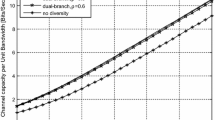Abstract
The present paper analyzes an L-branch maximal ratio combining (MRC) receiver over the Beaulieu-Xie (BX) fading channel. The expression of the probability density function (PDF) of the signal-to-noise ratio (SNR) of an MRC receiver in BX fading is derived by using the characteristic function approach. The obtained PDF is then utilized to calculate the various link-level and system-level parameters. This paper focuses on deriving closed-form expressions for different adaptive transmission techniques based on instantaneous channel state information in BX fading. The accuracy of our derived expressions is verified by comparing them with Monte Carlo simulations.









Similar content being viewed by others
Change history
13 May 2020
Eqs. 21, 22, and 23 were incorrectly captured in the original manuscript.
References
Simon MK, Alouini MS (2005) Digital communication over fading channels, 2nd edn. Wiley, New York
Shankar PM (2012) Fading and shadowing in wireless systems. Springer, New York
Recioui A, Bentarzi H (2013) Capacity optimization of MIMO wireless communication systems using a hybrid genetic-Taguchi algorithm. Wirel Pers Commun 71(2):1003–1019
Recioui A (2015) Application of a galaxy-based search algorithm to MIMO system capacity optimization. Arab J Sci Eng 41(9):3407–3414
Alouini MS, Goldsmith AJ (1997) Capacity of Nakagami multipath fading channels. In Proc. IEEE vehicular technology Conf. VTC’ 97, Pheonix, AZ, 358-362
Alouini MS, Goldsmith AJ (1999) Capacity of Rayleigh fading channels under different adaptive transmission and diversity- combining techniques. IEEE Trans Veh Technol 48(4):1165–1181
Milisic M, Hamza M, Hadziliac M (2009) BEP/SEP and outage performance analysis of L-branch maximal-ratio combiner for k-μ fading. International Journal of Digital Multimedia Broadcasting:1–8
Peppas KP (2010) Capacity of η−μ fading channels under adaptive transmission techniques. IET Commun 4(5):532–539
Zhang J, Tan Z (2012) Performance analysis of digital communication systems over composite η−μ/gamma fading channels. IEEE Trans Veh Technol 61(7):3114–3124
Singh S, Kansal V (2015) Performance of M-ary PSK over TWDP fading channels. International Journal of Electronics Letters 4(4):433–437
Kaur H, Kansal V, Singh S (2019) Effective rate analysis of two-wave with diffuse power fading channels. IET Commun 13(3):339–344
Singh AD, Subadar R (2015) Capacity analysis of MRC receiver with adaptive transmitters over TWDP fading channels. IEEE international symposium on advance computing and communication (ISSAC), 285-289
Zhao H, Liu Z, Alouini MS (2019) Different power adaption methods on fluctuating two-ray fading channels. IEEE Wireless Communications Letters 8(2):592–595
Beaulieu NC, Jiandong X (2015) A novel fading model for channels with multiple dominant specular components. IEEE Wireless Communications Letters 4(1):54–57
Olutayo A, Cheng J, Holzman JF (2017) Asymptotically tight performance bounds for selection diversity over Beaulieu-Xie fading channels with arbitrary correlation. IEEE international conference on communication (ICC), 1–6
Kansal V, Singh S (2017) Analysis of effective capacity over Beaulieu-Xie fading model. IEEE International Women in Engineering Conference on Electrical and Computer Engineering (WIECON-ECE), 2017, Dehradun, India, 207–210
Kansal V, Singh S (2018) Analysis of binary PSK modulations over the line-of-sight plus scatter fading model. Data Communication and Networks, Advances in Intelligent System and Computing, 13–20
Kansal V, Singh S (2018) Analysis of average symbol error probability of MDPSK MFSK and MPSK in the Beaulieu-Xie fading. 6th edition of international conference on Wireless Networks & Embedded Systems (WECON), 11–14
Gradshteyn IS, Ryzhik IM (1994) Table of integrals, series and products, 5th edn. Academic, San Diego
Funding
This work is supported by Visvesvaraya PhD Scheme for Electronics & IT, MeitY, India. The unique awardee number is VISPHD-MEITY-1674. V. Kansal and S. Singh (Department of ECE, Punjabi University, Patiala, India). E-mail: simranjit@pbi.ac.in
Author information
Authors and Affiliations
Corresponding author
Additional information
Publisher’s note
Springer Nature remains neutral with regard to jurisdictional claims in published maps and institutional affiliations.
The original version of this article was revised. Equations 21, 22, and 23 are corrected.
Rights and permissions
About this article
Cite this article
Kansal, V., Singh, S. Capacity analysis of maximal ratio combining over Beaulieu-Xie fading. Ann. Telecommun. 76, 43–50 (2021). https://doi.org/10.1007/s12243-020-00762-7
Received:
Accepted:
Published:
Issue Date:
DOI: https://doi.org/10.1007/s12243-020-00762-7




